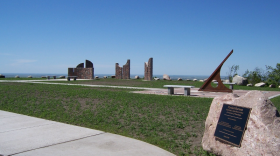
Chuck Lura has a broad knowledge of "Natural North Dakota"and loves sharing that knowledge with others. Since 2005, Chuck has written a weekly column, “Naturalist at Large,” for the Lake Metigoshe Mirror, and his “The Naturalist” columns appear in several other weekly North Dakota newspapers.
Lura was a long-time biology professor at Dakota College at Bottineau, publishing research on ecological aspects of grasslands in the northern Great Plains. In retirement, he continues to share his Natural North Dakota essays for the Prairie Public audience.
—
Natural North Dakota is supported by NDSU Central Grasslands Research Extension Center and Dakota College at Bottineau, and by the members of Prairie Public. Thanks to Sunny 101.9 in Bottineau for their recording services.
Hear Natural North Dakota on Prairie Public on Saturdays and Sundays at 8:35am CT.
-
When was the last time you saw a snapping turtle? Snapping turtles are one of four species of turtles native to North Dakota.
-
Have you ever noticed what looks like a mass of spit on a plant in the woods, on the prairie, or in your garden? I suspect that most of you probably have seen it, but probably gave it little attention. It is called spittle, and it’s produced by a type of insect called a spittlebug.
-
I recently read about the Natural Resource Conservation Service’s Turtle Mountain Conservation Delivery Unit and Plant Materials Center collaborating to provide interested tribal members information on how to grow sweetgrass in their gardens.
-
In 1907, the state of North Dakota designated the “Wild Prairie Rose” as the North Dakota State Flower.
-
Were there chimney swifts before chimneys? Of course! It might surprise you, but historically, chimney swifts nested in hollow trees, cliff faces, caves, and the like. But things changed for the chimney swifts when Europeans settled the area and built homes with chimneys.
-
Are you enjoying these long summer days? The days have been lengthening since the winter solstice back in December. And the longest day of the year, the summer solstice, is coming up soon.
-
If you haven’t been to Lake Metigoshe State Park, this summer should be a good time to go. Lying around fourteen miles northeast of Bottineau, the park is tucked away on the eastern shore of Lake Metigoshe’s north lake. It is a great place to enjoy a little natural North Dakota.
-
The northern lights have been unusually active over the past few months. And it appears we may be in for more frequent shows over the next few months.
-
Some birds are known to lay their eggs in another bird’s nest. They then go off while the “host” parent, or parents, get stuck with all the parental care of these young, often at the expense of their own offspring. And brown-headed cowbirds are notorious for this practice, called brood parasitism.
-
Wood warblers are known for their bright and interesting colors. They’re a bit smaller than the sparrows we commonly observe. Most are on their way north to the coniferous forest to nest, but some species will stay and nest here in North Dakota. If you have noticed one of these small birds has a prominent yellow rump patch, it is a yellow-rumped warbler. They are one of the more commonly observed wood warblers we see during the spring migration.










